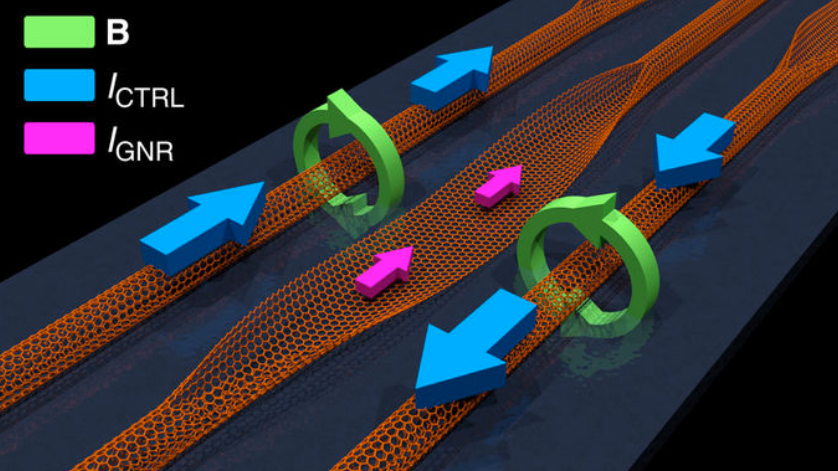Graphene-based computer would be 1,000 times faster than silicon-based, use 100th the power
How a graphene-based transistor would work. A graphene nanoribbon (GNR) is created by unzipping (opening up) a portion of a carbon nanotube (CNT) (the flat area, shown with pink arrows above it). The GRN switching is controlled by two surrounding parallel CNTs. The magnitudes and relative directions of the control current, ICTRL (blue arrows) in the CNTs determine the rotation direction of the magnetic fields, B (green). The magnetic fields then control the GNR magnetization (based on the recent discovery of negative magnetoresistance), which causes the GNR to switch from resistive (no current) to conductive, resulting in current flow, IGNR (pink arrows) — in other words, causing the GNR to act as a transistor gate. The magnitude of the current flow through the GNR functions as the binary gate output — with binary 1 representing the current flow of the conductive state and binary 0 representing no current (the resistive state). (credit: Joseph S. Friedman et al./Nature Communications)
A future graphene-based transistor using spintronics could lead to tinier computers that are a thousand times faster and use a hundredth of the power of silicon-based computers.
The radical transistor concept, created by a team of researchers at Northwestern University, The University of Texas at Dallas, University of Illinois at Urbana-Champaign, and University of Central Florida, is explained this month in an open-access paper in the journal Nature Communications.
Transistors act as on and off switches. A series of transistors in different arrangements act as logic gates, allowing microprocessors to solve complex arithmetic and logic problems. But the speed of computer microprocessors that rely on silicon transistors has been relatively stagnant since around 2005, with clock speeds mostly in the 3 to 4 gigahertz range.
Clock speeds approaching the terahertz range
